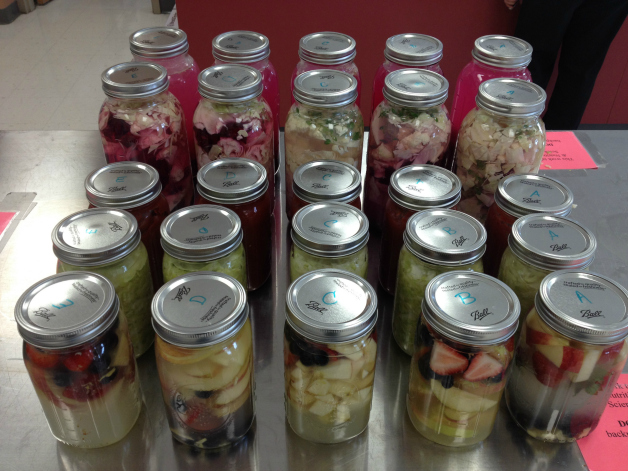Embrace Fermented Foods
/One thing that the modern American diet is lacking that most traditional diets contain is fermented foods. Traditionally, cultures have used fermentation to preserve food prior to the invention of refrigeration. As with most traditional wisdom, this technique was beneficial to human health in many different ways that science continues to specifically identify. Fermented foods are more easily digested because the proteins are already partially broken down. And most importantly, they support good bacteria in our digestive tract, which is necessary for optimal health.
Everyday we rely on bacteria in our gut to keep us healthy. Yup, bacteria for health. Perhaps you've heard about this, probiotics are getting a lot of attention these days. Of course, the reason that probiotics are getting so much attention is that 1) people are having a lot of health, especially digestive-related, issues and 2) it threw a wrench in our bacteria-fearing belief system. So yes, we need certain bacteria. And we actually have a huge amount of "good bacteria" living inside of us everyday making things run smoothly. The stats tend to vary on this, but in general we have hundreds of different species of bacteria living in our gut, which are comprised of 10 times as many microorganisms as we have human cells. This is still a relatively new topic for scientific understanding in our modern biomedical model, but traditional/cultural methods of food preparation have been supporting this knowledge for a long time. Fermentation. Heard of it? Specifically lacto-fermentation, with the "lacto" referring to lactic acid producing bacteria known as lacto-bacilli. I bet you've heard of that one. That's what is listed on many yogurt containers. Lacto-fermentation was originally developed to preserve food; the lactic acid inhibits the growth of putrefying bacteria. Lacto-fermented food also does a whole bunch of super cool things such as: start the digestive process, aid digestion, increase vitamin levels (esp vitamin C), help maintain blood pressure, promote healthy bacteria throughout the gut and boost the immune system. Rad, right?!
Keep this knowledge in mind throughout your life when things might happen that could potentially disrupt your gut ecosystem. For example, antibiotics. I'm not a huge fan of antibiotics, I think they are way overused in this country. Again, I could get on a soap box about that one, but I also do understand that there are times when antibiotics are truly necessary. Just remember, with the interconnectedness of all systems within our bodies, it is very hard to adjust one thing without it having consequences somewhere else. If you are going to be on antibiotics, this might be an excellent time to include some extra ferments in your diet.
HOW TO FERMENT:
What you need: (for jar fermentation)
1. Jar with a two-piece lid
2. Good quality sea salt
3. Time: a couple days to a couple weeks
4. Temperature: approx. room temperature 68-72 is ideal
5. (If you are not vegan) A fermenting agent: whey, or a kefir or yogurt starter
Fermenting can be vegan, you can drop the fermenting agent and just use salt and water.
I've been taught 2 Tablespoons of salt per 1 quart of vegetables. I find this to be too salty so I use 2 teaspoons per 1 quart. Put veggies in jar, mix salt with enough water to cover the vegetables. Leave about an inch of air at the top of jar. Seal lid tight, let sit for approx. 2-7 days. It's ready when the lid no longer has any give in it. Then stick it in the fridge where it will keep for several months. (Hotter room temperatures will ferment faster, colder will ferment slower. Check the lid for firmness.)
If dairy is not a issue, use 1 teaspoon salt and 1/4 cup liquid whey for 1 quart of vegetables. Or dissolve one packet of starter in water plus 1 Tablespoon salt for 1 quart of vegetables. Again, cover vegetables with water, leave 1 inch at the top. Leave at room temperature for approx. 2-7 days. When the lid is firm, they are ready. It will keep in the fridge for several months. Note: You can buy whey or simply strain it out of yogurt yourself.
*The above are general guidelines. Different foods, such as beverages, vary. But the above is a good rule of thumb.
Below I've included some fun pictures and recipes of lacto-fermented foods that you can make at home. Be careful, though. When first introducing ferments into one's diet, slow and steady is key. Just a tiny bit to start while your body adjusts or else you may have some rather undesirable detox reactions. Happy Fermenting!
Sauerkraut - 1 quart
1 med cabbage shredded
(Optional-- Any additional vegetables of choice, chopped)
2 tsp salt
*** For cabbage, knead it with your hands in a bowl (after it is shredded and salted) to use its own water. No need to add additional water, just squish out the cabbage juice!
Take salt, cabbage and cabbage water. Add to jar. Make sure water covers all vegetables and there is 1 inch of space at the top. Needs approx. 3-5 days to sit on counter. Will keep 3 months in fridge.
Beet Kvass - 2 quarts
1 med beet chopped
1 T salt
5 cloves garlic chopped
1 cup whey
Water to fill
Chop beet and garlic. Add all ingredients to jar. Fill with water until 1 inch of space remains. Needs approx. 2-5 days to sit on counter. Drink diluted or undiluted with water depending on personal taste. Drink about 2 ounces a day. Or start off smaller if necessary.
Fruit Kvass - 1 quart
1 apple chopped
1 handful berries
1 inch ginger sliced or minced (your preference)
1/2 cup whey
Water to fill
Put ingredients in jar, fill with water leaving 1 inch at top. Sit in room temperature 2-3 days. It will last in fridge a few weeks. Drink a couple ounces a day, or start off smaller.
*Kvass can be made with any fruit combo, vegetable combo or fruit and vegetable combo. Experiment!
Fermented Ketchup 1/2 quart
12 ounces of tomato paste (buy it in jars, rather than cans if possible)
1/8 cup of whey
1/8 cup maple syrup
1 T sea salt
1 clove garlic mashed
Mix ingredients together. Fill jar. Sit in room temperature about 2 days. Transfer to fridge. If you prefer thinner ketchup, add water after fermentation.















